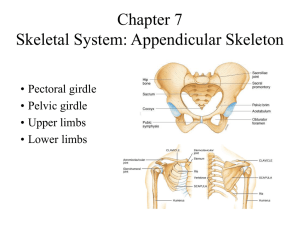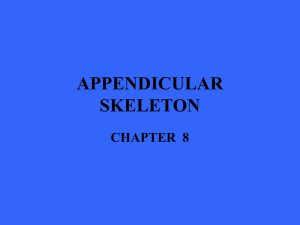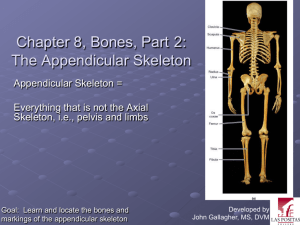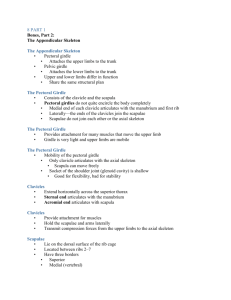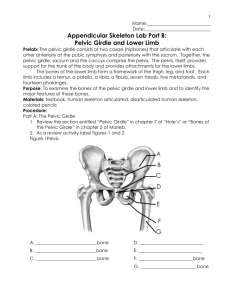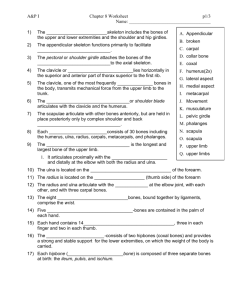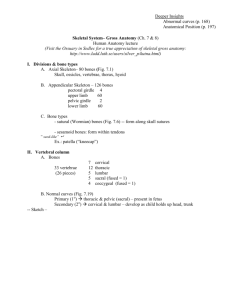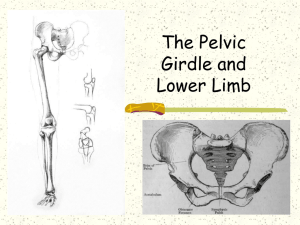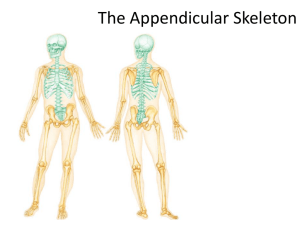(2) Anat 35 Appendicular Skeleton S11
advertisement
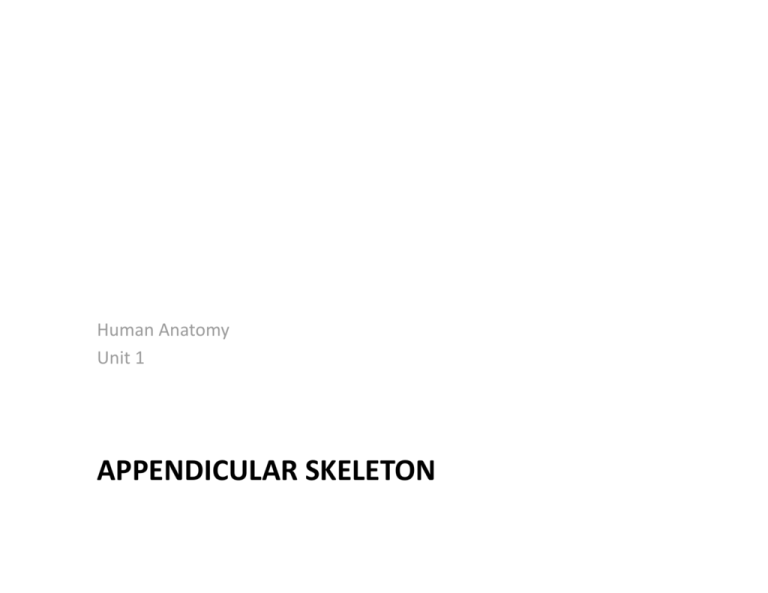
Human Anatomy Unit 1 APPENDICULAR SKELETON Components • Pectoral girdle – clavicle – scapula • Upper limb – brachium – antebrachium – carpus – manus • Pelvic girdle – os coxae – sacrum • Lower limb – femoral region – crural region – tarsal region – pedal region Appendicular Skeleton Pectoral Girdle • Shoulder girdle • Composed of: – 2 clavicles – 2 scapulae • Loose aDachments – Joints • Sternoclavicular joint • Acromioclavicular joint • Humeroscapular joint – allows for wide range of moGon – Easy to dislocate • Not weight bearing Clavicle • Braces the shoulder • Usually stronger on right than leK • Most commonly fractured bone in body Scapula • Borders – Superior – Medial – Lateral • Angles – Superior – Inferior – Lateral • Acromion • Coracoid process • Glenoid cavity • Suprascapular notch • Subscapular fossa • Posterior surface – Spine – Supraspinous fossa – Infraspinous fossa Upper Limb • Brachium – Shoulder to elbow – Humerus • Antebrachium – Forearm – Radius – Ulna • Carpus – Wrist – 8 bones in two rows • Manus – Hand – 19 bones • 5 metacarpals • 14 phalanges Humerus ADachment for biceps muscle ArGculates with glenoid cavity of scapula Common fracture site ADachment for deltoid muscle ArGculates with radius Accommodates olecranon of ulna when elbow is flexed ArGculates with ulna Accommodates olecranon of ulna when elbow is extended “Funny bone” Protects ulnar nerve Wraps around trochlea of humerus Ulna InserGon of biceps Palpable proximal to thumb Radius Art. with end of ulna Art. with scaphoid & lunate bones Bony point of elbow ADaches radius and ulna Carpal Bones • Form wrist • Two rows with four bones each – Proximal row • • • • Scaphoid (navicular) Lunate Triquetral Pisiform – Sesamoid bone – Distal row • • • • Trapezium Trapezoid Capitate Hamate – Hamulus (hook) Carpals, metacarpals, and phalanges polex Pelvic Girdle • Composed of: – Os coxae (innominate bone) – Sacrum • FuncGon – Supports trunk on legs – Encloses and protects viscera of pelvic cavity Interpubic disc joins pelvis at pubic symphysis opening Fuse in childhood Sexual Dimorphism of Pelvis • Male pelvis – Thicker and heavier – Sacrum is narrower and deeper – Less movable coccyx – Smaller, heart‐shaped pelvic outlet – Pubic arch ≤90o • Female pelvis – Wider and shallower – Larger pelvic inlet and outlet – Coccyx more movable – Pelvic inlet is round or oval – Hips more flared – Pubic angle >100o Anatomic VariaGon of Pelvis by Gender Lower Limb • Adapted for weight bearing and locomoGon • Four regions with 30 bones per limb – Thigh (femoral) • Femur • Patella (sesamoid bone) – Leg (crural) • Tibia • Fibula – Pedal • 7 tarsal bones • 5 metatarsal bones • 14 phalanges Anterior View of Femur ADached via ligament to acetabulum Sesamoid bone develops when child begins to walk Posterior View of Femur Tibia and Fibula Anterior view Posterior view Foot • Tarsals – Proximal • Talus • Calcaneus • Navicular – Distal • 1st, 2nd, 3rd cuneiforms • Cuboid • Metatarsals – I‐V • Phalanges • Arches – Medial longitudinal – Lateral longitudinal – Transverse Dorsum of the Foot Plantar Surface of the Foot Halux


